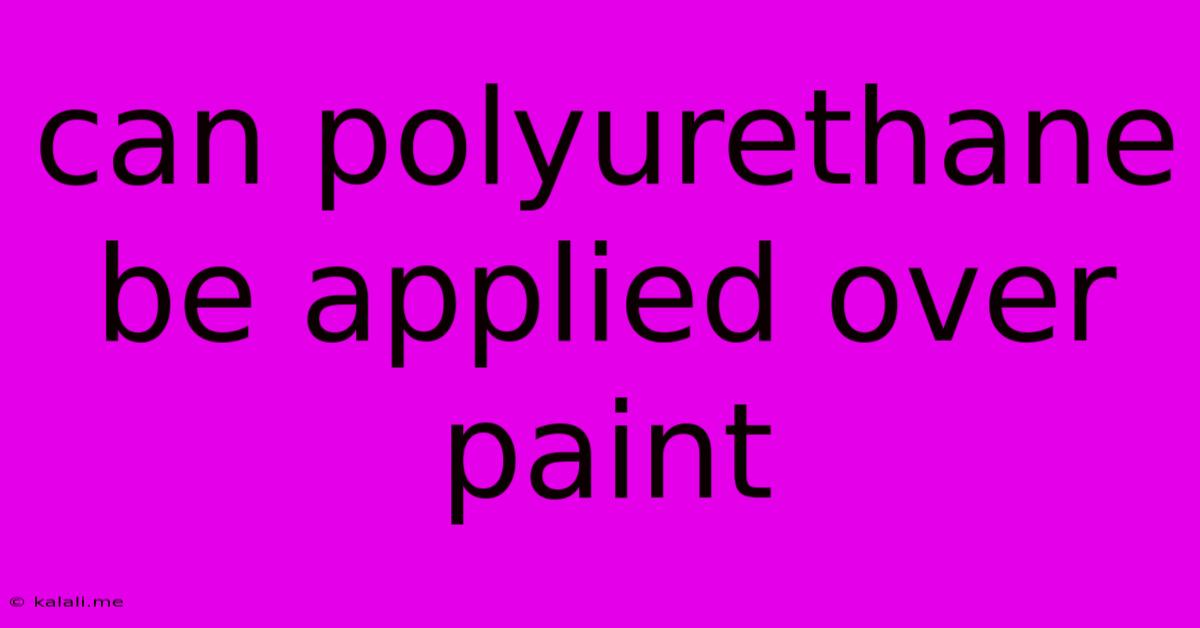Can Polyurethane Be Applied Over Paint
Kalali
Jun 06, 2025 · 3 min read

Table of Contents
Can Polyurethane Be Applied Over Paint? A Comprehensive Guide
Meta Description: Wondering if you can apply polyurethane over paint? This comprehensive guide explores the pros, cons, and crucial steps for a successful finish, covering different paint types and polyurethane varieties. Learn how to prep your surface for optimal adhesion and a long-lasting, beautiful result.
Applying polyurethane over paint is a common question among DIY enthusiasts and professional finishers alike. The answer, however, isn't a simple yes or no. The success of this process hinges on several factors, including the type of paint already on the surface, the type of polyurethane you choose, and the proper surface preparation. This guide will delve into the specifics to help you make an informed decision.
Understanding Paint and Polyurethane Compatibility
Before diving into the application process, it's crucial to understand the compatibility between your existing paint and the polyurethane you intend to use. Not all paints and polyurethanes are created equal.
Types of Paint:
- Oil-based paints: Generally offer good adhesion and are compatible with oil-based polyurethanes. However, they require thorough drying time before applying polyurethane.
- Latex paints (water-based): Also compatible with polyurethane, but require proper cleaning and preparation to ensure good adhesion. Water-based polyurethanes are often the preferred choice for latex paints.
- Acrylic paints: Similar to latex paints in terms of compatibility with polyurethane. Again, proper surface preparation is paramount.
- Enamel paints: Usually very durable and offer a good base for polyurethane application.
Types of Polyurethane:
- Oil-based polyurethane: Offers a durable, high-gloss finish, but has a stronger odor and longer drying time. Requires thorough ventilation during application.
- Water-based polyurethane: Lower odor, faster drying time, and easier cleanup. A good option for both interior and exterior use, particularly with latex or acrylic paints.
Preparing the Surface for Polyurethane Application
Proper surface preparation is the key to a successful finish. Regardless of the paint type, these steps are crucial:
- Cleaning: Thoroughly clean the painted surface to remove any dust, dirt, grease, or other contaminants. Use a mild detergent and water, followed by a thorough rinsing and complete drying.
- Sanding: Lightly sand the painted surface with fine-grit sandpaper (220-grit or higher) to create a slightly rough surface for better adhesion. Avoid excessive sanding, which could damage the underlying paint.
- Priming (if necessary): If the existing paint is very glossy or shows signs of chipping, applying a primer before the polyurethane can significantly improve adhesion. Choose a primer compatible with both your existing paint and chosen polyurethane.
- Inspection: Carefully inspect the surface after cleaning and sanding. Repair any cracks or imperfections before applying polyurethane.
Applying the Polyurethane
Once the surface is properly prepared, you can apply the polyurethane. Follow these steps for best results:
- Thin coats: Apply thin, even coats of polyurethane to avoid runs and drips. Multiple thin coats are better than one thick coat.
- Drying time: Allow each coat to dry completely before applying the next. Drying times vary depending on the type of polyurethane and environmental conditions. Refer to the manufacturer's instructions for specific drying times.
- Ventilation: Ensure adequate ventilation, especially when using oil-based polyurethane.
- Application tools: Use a high-quality brush, roller, or spray gun for even application.
Potential Problems and Solutions
Even with proper preparation, you might encounter some challenges:
- Poor adhesion: This usually indicates inadequate surface preparation. Re-clean and sand the surface before reapplying the polyurethane.
- Yellowing: Oil-based polyurethane may yellow over time, especially in areas exposed to sunlight. Water-based polyurethane is less prone to yellowing.
- Runs and drips: Apply thin coats and allow adequate drying time between coats.
Conclusion
Applying polyurethane over paint is achievable with careful planning and execution. By understanding the compatibility of your paint and polyurethane, thoroughly preparing the surface, and following the application instructions carefully, you can achieve a beautiful and durable finish. Remember to always consult the manufacturer’s instructions for your specific products for optimal results. With the right approach, your project can be a success!
Latest Posts
Latest Posts
-
Which One Is Faster A Rocket Or A Jet
Jun 07, 2025
-
Animal Crossing New Leaf Coffee Guide
Jun 07, 2025
-
Does The Transedental Argument For God Work
Jun 07, 2025
-
Is A Triangle Isoceles If Two Sides Are The Same
Jun 07, 2025
-
Another Word For Getting Someone Angry
Jun 07, 2025
Related Post
Thank you for visiting our website which covers about Can Polyurethane Be Applied Over Paint . We hope the information provided has been useful to you. Feel free to contact us if you have any questions or need further assistance. See you next time and don't miss to bookmark.